Nec ND-2500A
5. DVD Error Correction Tests
Review Pages
2. Data CD Reading Tests
3. CD Error Correction Tests
4. DVD Reading Tests
5. DVD Error Correction Tests
6. Protected Disc Tests
7. CD-DA - DAE Tests
8. CD Recording Tests
9. 3T Jitter Tests - Page 1
10. 3T Jitter Tests - Page 2
11. C1 / C2 Error Measurements
12. DVD Recording Tests
13. KProbe PI/PO Error Measurements
14. Conclusion
NEC ND-2500A DVD±RW recorder - Page 5
DVD Error Correction Tests
In the following tests we examined the DVD reading capabilities of the NEC ND-2500A drive with scratched / defective DVD media. For the tests we used CDVD Benchmark and Nero CDSpeed. The reference test media come from ALMEDIO.
- Single Layer media
ABEX TDR-821
This is a single sided, single layer DVD-ROM with a 4.7GB capacity, and its surface has an artificial scratch of dimensions varying from 0.4 to 3.0 mm. The following transfer rate picture comes from the CDVD Benchmark v1.21 transfer rate test.
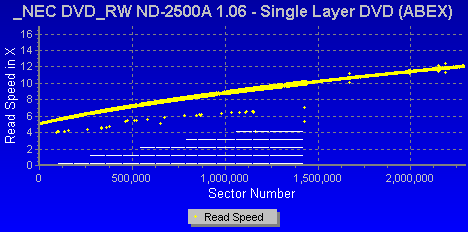
The drive read the contents of the 821 test disc without reporting any reading error. There were no speed deviations while reading the defective areas on the disc's surface. The resultant graph is clean and smooth.
ABEX TDR-825
This is also a single sided, single layer DVD-ROM of 4.7GB capacity. The data structure of the disc is exactly the same as that of the TDR-821, with the difference that there are no scratches on the surface and instead defective areas ranging in dimensions from 0.5 to 1.1 mm. There are also fingerprints with height between 65 and 75 micrometers.

Again a very clean effort. The drive managed to successfully read the defective areas on the disc.
- Dual Layer media
ABEX TDR-841
This is an 8.5GB dual layer, single sided DVD-ROM disc with artificial scratches of dimensions ranging from 0.4 to 3.0mm, on both layers.
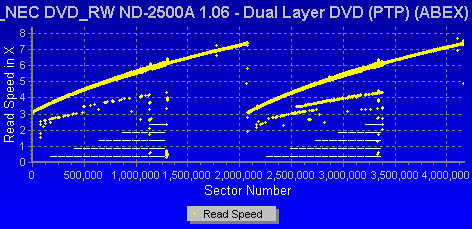
Once again the disc was read without any reading errors. However, the drive had a few more problems reading this disc. The yellow dots which have formed what is almost a second line below the main, thicker line over the defective areas, especially in the second layer, are the drive's attempts to read through the defects by changing (droppping) speed.
ABEX TDR-845
This disc is a single sided, dual layer DVD-ROM disc with capacity of 8.5GB. The only difference between the TDR-845 and the TDR-841 is that the first includes both defective areas and fingerprints. The dimensions of the defective areas range from 0.5 to 1.1 mm and the fingerprints have height sized from 65 to 75 microns (micrometers).
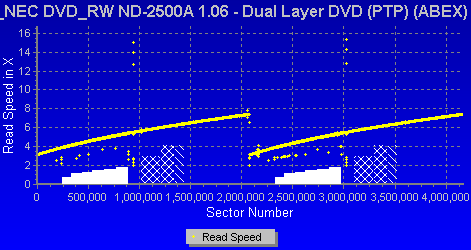
The test finished successfully without reporting any error. Again a very clean output.
ABEX TDV-541
The TDV-541 is a single sided, dual layer DVD-VIDEO disc, with a capacity of 8.5GB.The disc is based on the TDV-540 series which is designed for inspection and adjustment of DVD-VIDEO players. The disc checks the layer switch operation from layer 0 to layer 1 and also includes test pictures and test signals for DVD sound files. The current TDV-541 also checks the error correcting capabilities of the drive and includes scratches sized from 0.4 to 3.0 mm.
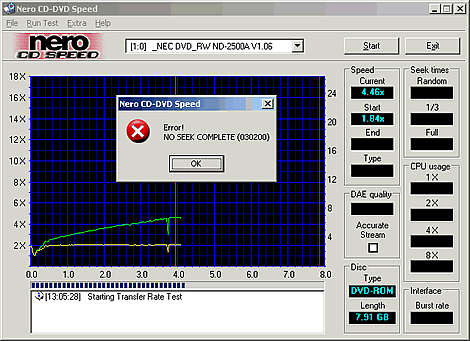
Unfortunately the drive did not manage to read the contents of the ABEX TDV-541 test disc. As can been seen from the graph above, reading failed while reading the beginning of the second layer of the disc. We made several attempts but the drive failed each time.
ABEX TDV-545
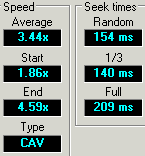 The
TDV-545 disc is based on the TDV-540 series. It is a single sided, dual layer
Video/S-2 disc with a capacity of 8.5GB. The TDV-545 includes artificial
black dots on the disc's surface, sized from 0.4 to 1.0 mm. It also has 65
- 75 micrometer high fingerprints.
The
TDV-545 disc is based on the TDV-540 series. It is a single sided, dual layer
Video/S-2 disc with a capacity of 8.5GB. The TDV-545 includes artificial
black dots on the disc's surface, sized from 0.4 to 1.0 mm. It also has 65
- 75 micrometer high fingerprints.
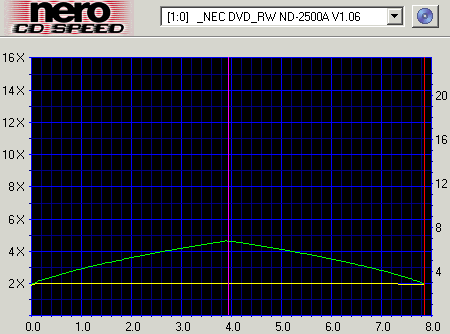
This test disc posed no problems for the NEC drive, which read past the black dots and fingerprints on the disc's surface. The maximum speed of 4.59x however was a little slow.
Review Pages
2. Data CD Reading Tests
3. CD Error Correction Tests
4. DVD Reading Tests
5. DVD Error Correction Tests
6. Protected Disc Tests
7. CD-DA - DAE Tests
8. CD Recording Tests
9. 3T Jitter Tests - Page 1
10. 3T Jitter Tests - Page 2
11. C1 / C2 Error Measurements
12. DVD Recording Tests
13. KProbe PI/PO Error Measurements
14. Conclusion













